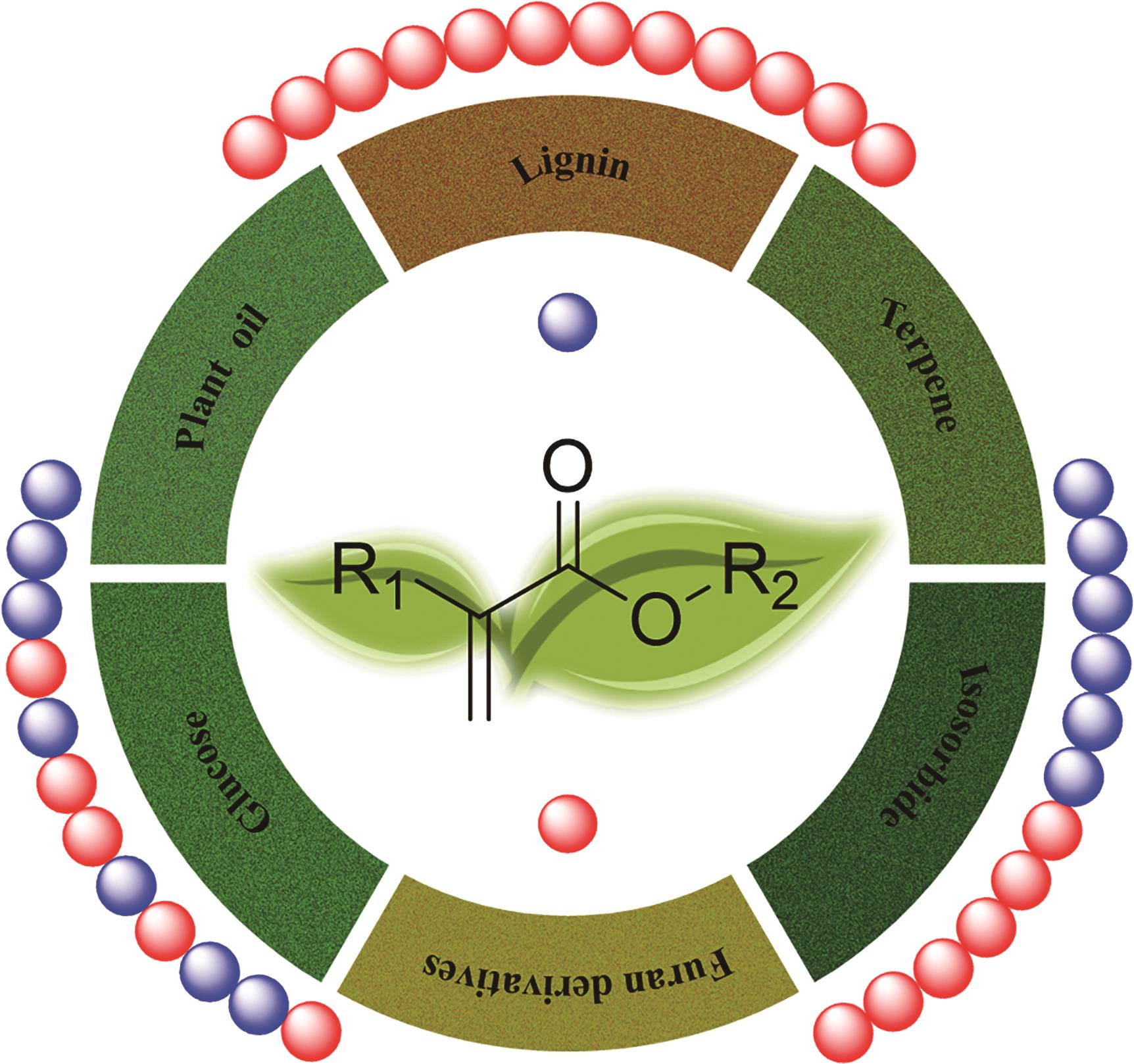Abbreviation (ISO4): Prog Chem
Editor in chief: Jincai ZHAO


Synthesis and Polymerizations of Bio-Based (meth)Acrylates
Yuchen Yang, Zhenjie Liu, Chunhua Lu, Kai Guo, Xin Hu, Ning Zhu
Prog Chem ›› 2025, Vol. 37 ›› Issue (3) : 383-396.
Synthesis and Polymerizations of Bio-Based (meth)Acrylates
As an important family of synthetic polymers, poly(meth)acrylates have a wide range of applications in the fields of coatings, adhesives, biomedines, electronic and electrical materials. However, the (meth)acrylates monomers are mainly derived from petrochemical resources.Transformations of biomass into (meth)acrylate monomers and polymers have attracted growing research interest from the viewpoint of sustainability. The bio-based poly(meth)acrylates not only serve as the supplement for the fossil based product but also provide great chance for the development of value-added high performance materials with designed novel structures. This article highlights the recent progress in the synthesis and polymerization of bio-based (meth)acrylates. The lignin, terpene, plant oil, glucose, isosorbide, and furan derivatives as the biomass feedstock are respectively reviewed in consecutive order. The properties and applications of the corresponding bio-based poly(meth)acrylates are summarized. Moreover, the challenges and opportunities of bio-based poly(meth)acrylates are also discussed.
1 Introduction
2 Preparation of bio-based (meth)acrylates and polymers from lignin
3 Preparation of bio-based (meth)acrylates and polymers from terpene
4 Preparation of bio-based (meth)acrylates and polymers from plant oils
5 Preparation of bio-based (meth)acrylates and polymers from glucose
6 Preparation of bio-based (meth)acrylates and polymers from isosorbide
7 Preparation of bio-based (meth)acrylates and polymers from furan derivatives
8 Conclusion and outlook

biomass transformation / (meth)acrylates / radical polymerizations / bio-based materials
| [1] |
|
| [2] |
|
| [3] |
|
| [4] |
|
| [5] |
|
| [6] |
|
| [7] |
|
| [8] |
|
| [9] |
|
| [10] |
|
| [11] |
|
| [12] |
|
| [13] |
|
| [14] |
|
| [15] |
|
| [16] |
|
| [17] |
|
| [18] |
|
| [19] |
|
| [20] |
|
| [21] |
|
| [22] |
|
| [23] |
(马晓振, 罗清, 秦冬冬, 陈景,朱锦,颜宁. 化学进展, 2020, 32(5): 617..).
|
| [24] |
|
| [25] |
|
| [26] |
|
| [27] |
|
| [28] |
|
| [29] |
|
| [30] |
|
| [31] |
|
| [32] |
|
| [33] |
|
| [34] |
|
| [35] |
|
| [36] |
|
| [37] |
|
| [38] |
|
| [39] |
|
| [40] |
|
| [41] |
|
| [42] |
|
| [43] |
|
| [44] |
|
| [45] |
|
| [46] |
|
| [47] |
|
| [48] |
|
| [49] |
|
| [50] |
|
| [51] |
|
| [52] |
|
| [53] |
|
| [54] |
|
| [55] |
|
| [56] |
|
| [57] |
(孙佳, 王普, 章鹏鹏, 黄金. 化学进展, 2016, 28(9): 1426..).
|
| [58] |
|
| [59] |
|
| [60] |
|
| [61] |
|
| [62] |
|
| [63] |
|
| [64] |
|
| [65] |
(黄辉, 韩超, 谭天伟.工业催化, 2008, 16(10):154..).
|
| [66] |
(李玉皎, 于道永. 化工进展, 2010, 29(04):683.).
|
| [67] |
|
| [68] |
|
| [69] |
|
| [70] |
|
| [71] |
|
| [72] |
|
| [73] |
|
| [74] |
|
| [75] |
|
| [76] |
|
| [77] |
|
| [78] |
|
| [79] |
|
| [80] |
|
| [81] |
|
| [82] |
|
| [83] |
(刘雪晨, 邢娟娟, 王海鹏, 周沅逸, 张玲, 王文中. 化学进展, 2020, 32(9): 1294..).
|
| [84] |
|
| [85] |
(黄卫军, 朱宁, 方正, 郭凯. 化学进展, 2018, 30(12): 1836..).
|
| [86] |
|
| [87] |
|
| [88] |
|
| [89] |
|
/
| 〈 |
|
〉 |